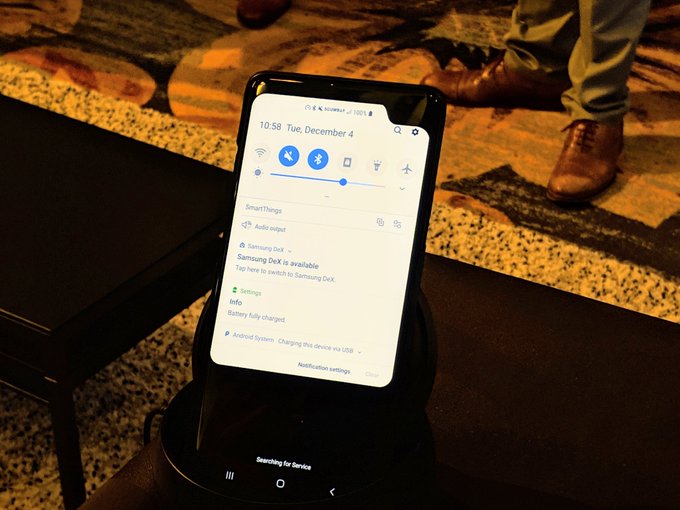Samsung Galaxy X release date, price, rumours, leaks, everything you need to know about the foldable smartphone
Samsung hopes to convince you to pay £1,000+ for an OLED display that folds-up like the pages of a paperback
Faced with increasingly tough competition from the likes of Huawei, Xiaomi, and OnePlus, Samsung is gearing up to unveil something entirely new in the form of a smartphone which has been nicknamed the Samsung Galaxy X.
After months of speculation, whispers and leaks, Samsung finally offered a brief glimpse at what it has planned for this next-generation flagship handset during its annual Developer Conference in San Francisco on November 7, 2018: a folding phone.
Speaking at the conference, Justin Denison, SVP of Mobile Product Marketing, produced a prototype of the Galaxy X from his pocket to rapturous applause from the crowd. Although the phone itself doesn't have an official name yet, the flexible display does.
Samsung is calling it the Infinity Flex Display.
The technology will not only be used for the so-called Galaxy X – or whatever it is called when it launches next year – mobile DJ Koh says the Infinity Flex Display will be used in a swathe of different devices, including more foldable tablets, and laptops.
Samsung clearly thinks its new technology will mark a massive change in the market.
Well, if you've cracked the engineering challenge of foldable screens – and it appears Samsung has – you might as well put them in everything. Folding 4K TVs, anyone?
Read on to find out everything we know about Samsung's folding smartphone so far.
- The top 5 foldable phones to expect in 2019
- These are the best smartphones you can buy now

It's a phone!

No, hang on – it's a tablet!
SAMSUNG GALAXY X FIRST LOOK
The foldable Galaxy X was unveiled at Samsung's Developer Conference held in the Moscone West convention centre in San Francisco on November 7, 2018.
Although we did technically get an early look at the smartphone in both its unfolded and folded forms, Justin Denison explained on stage "we've disguised some elements of the design but trust me, there's a device inside here and it is stunning."
That's good news because the Galaxy X didn't look particularly stylish when it was unveiled on-stage – with sharp, boxy corners and a chunky frame. It'll be interesting to see whether the finished article keeps the same design language used on the most recent Samsung Galaxy S and Galaxy Note handsets, including curved sides, centred rear-mounted camera and curved edges of the display.
Here's your first official look at the new handset in action.
SAMSUNG GALAXY X RELEASE DATE
Unfortunately, despite offering a fleeting glimpse at the pliable handset, no release date for the next-generation handset was revealed. However, Samsung SVP Denison did say "we'll be ready to start mass production in the coming months."
That tallies with the release date rumours leading up to the event – the Galaxy X won't launch until the first half of 2019. Samsung previously hinted its first foldable handset might be unveiled on-stage at CES 2019 in early January, or MWC 2019 in late February, two of the biggest technology expositions.
Well, it wasn't publicly shown at CES, though it did apparently get a private viewing, and we may not have to wait until MWC for our first look at the finished handset. That's because the latest leaks say that the Galaxy X will be unveiled on Wednesday 20 February 2019 at Samsung Galaxy Unpacked events in San Francisco and London. That's also the event where Samsung will launch its trio of Galaxy S10 smartphones, and perhaps its Galaxy Sport smartwatch, too.
But in terms of actually buying one? Immediately after the Unpacked reveal sounds a little optimistic. We're guessing a public release date of March/April 2018 at the earliest.
That gives you a bit of time to start saving because...
SAMSUNG GALAXY X PRICE
The Samsung Galaxy X is not going to be cheap. Samsung declined to confirm the final price tag for the Galaxy X when it showed off the somewhat-disguised handset. However, one thing is for certain – this is going to be a very expensive gadget.
According to a leaked report in the Korea Times, sources suggest this entirely-new category of folding handsets could mean paying a premium for the limited initial run of devices. As such, the Galaxy X priceis expected to be around the 2 million Korean won mark, which is about £1,365 – and that's beforetaxes.
Given the maxed-out Galaxy Note 9 already costs £1,099 ($1,249.99) – and that only has one screen – it would seem inevitable the next-generation folding smartphone will spiral even higher than that.
Californian technology firm Royole recently launched a folding phone, which sports a single, pliable OLED display – not the two that will be included on the Galaxy X, and that still topped £999 ($1,300).
So if you want the coolest smartphone of 2019, you'd better start saving for it.

SAMSUNG GALAXY X NAME
In absence of an official name for the folding phone, we're referring to it as the Samsung Galaxy X. Other names that have surfaced are the Samsung Galaxy F, the Samsung Galaxy Fold and the Samsung Rize.
While Samsung Galaxy Fold seems feasible from a literal point of view, it also seems a bit too literal for it to be the final name. But we could be wrong and then maybe the Samsung Galaxy S10 will actually be called the Samsung Galaxy Doesn't Fold when it get announced.
SAMSUNG GALAXY X SCREEN
Samsung Galaxy X has two OLED displays, although only one has the ability to fold.
The front of the Galaxy X sports a 4.5-inch screen, known as the Cover Display. According to the South Korean firm, this OLED display will work in a similar fashion to existing Samsung handsets. Based on the heavily-disguised prototype unveiled on-stage during the developer conference, the Galaxy X appears to have chunky bezels at the top and bottom of the handset.
If you're looking for more screen real estate than is available with the 4.5-inch Cover Display, opening up the handset reveals a second screen that's almost twice the size.
The foldable 7.3-inch Infinity Flex Display unfurls like the pages of a paperback to offer a bigger screen when playing games, watching movies, or running up to three applications side-by-side – a new feature that is called "multi active window".
Apps that are running on the smaller 4.6-inch cover display when users unfold the larger tablet display will appear on the bigger screen in the same state you left them.
Updated software will expand to take full advantage of the larger display. For example, news aggregate Flipboard expanded from a single column view on the 4.6-inch display, to three columns when viewed on the 7.3-inch screen. Developers will have to update their software to take advantage of the changing display sizes.
"We've been living in a world where the size of your screen can only be as large as the device itself," Samsung SVP Denison revealed to developers at the conference.
"Well, we've just added a new dimension. The Infinity Flex Display is the foundation for the smartphone of tomorrow."
He added that the phone can be folded “hundred of thousands of times” without getting damaged.

SAMSUNG GALAXY X SOFTWARE
How will the Galaxy X adapt to users swap between the Cover Display and the 7.3-inch folding tablet screen, and will applications move from one screen to the other seamlessly? That'll be just fine, Samsung has promised.
Samsung has overhauled its mobile OS ahead of the announcement of its foldable Galaxy X. Gone is TouchWiz – the Android skin designed by Samsung and used on its smartphone range since June 2010 – replaced instead with One UI.
"The Infinity Flex Display together with One UI delivers a new kind of mobile experience allowing users to do things they couldn’t do with an ordinary smartphone," Samsung said. "Users now have the best of both worlds: a compact smartphone that unfolds to reveal a larger immersive display for multitasking and viewing content. The app experience seamlessly transitions from the smaller display to the larger display as the device unfolds."
One UI will also enable the Samsung Galaxy X to run three apps simultaneously when in tablet mode, while the redesigned icons mean that "the rounded corner of our hardware is reflected in our software," according to Jee Won Lee, Senior Designer of UX Design at Samsung Mobile.
Following the announcement of the Galaxy X, Google confirmed plans to bake support for foldable displays into the Android operating system itself. Huawei, LG and Microsoft are all tipped to have a folding handset in the works.

In order to prevent the fragmentation of Android as each manufacturer designs and programs their own software solution for folding displays, Google has announced plans to build the functionality directly into the operating system itself.
Speaking during the Android Developer Summit in November, Google Vice President of Engineering Dave Burke said the company is “enhancing Android to take advantage of this new form factor with as little work as necessary.”
Google typically holds its annual developer conference, Google IO, in May. We'd bet our firstborn that the Mountain View-based company has plenty more about its optimisation for foldable handsets to share with software designers during IO 2019.
One UI will be tested on the Galaxy S9, S9+ and Note 9 in open beta, which should help to iron out any bugs before the launch of the Galaxy X.
You can read more about One UI and how to join the open beta – which is open to participants in the US, UK, India, China, South Korea, Germany, France, Spain and Poland – at Samsung's new One UI website.

SAMSUNG GALAXY X FEATURES
No features were shown off at the official Galaxy X debut in San Francisco.
However, Samsung mobile chief DJ Koh said previously revealed the long-awaited folding flagship will offer similar functionality to a tablet when the screen is unfurled, while the folding mechanism would allow the handset to be packed away to a portable and pocketable size.
In an interview with CNET, Koh talked about his ambitions for the new flagship phone, stressing that the foldability of the Galaxy X will not just be a gimmick, but will instead offer delicious new features and experiences for users.
Increasing the amount of screen real estate available on a smartphone is important, according to the Samsung chief. When the company first launched its Galaxy Note series back in October 2011, the 5.3-inch display was widely mocked for its size.
However, DJ Koh notes, after eight generations of the phablet, large-screen devices are now ubiquitous – with rival iPhone XS Max now offering a 6.5-inch display and Google Pixel 3 XL sporting a 6.3-inch screen.
"Possibly when we start selling the foldable phone, it may be a niche market, but definitely, it will expand," Koh said. "I'm positive that we do need a foldable phone."
"When we deliver a foldable phone, it has to be really meaningful to our customer," Koh revealed after the Galaxy A9 launch keynote earlier this year. "If the user experience is not up to my standard, I don't want to deliver those kind of products."
Interestingly, Samsung patents suggest Galaxy X will be compatible with its S Pen digital stylus – either the current Note one, or a new variant. That fits with rumours we've heard that the Galaxy S and Galaxy Note lines could merge next year.

Samsung patent
Other features that could be included, although we have no concrete idea, are all the ones mooted for the other 2019 Galaxy – the Samsung S10. So there might be 5G connectivity and an in-screen fingerprint reader... or there might not.
Given the amount of innovation already in the Galaxy X around its screen, Samsung might very well to keep the rest of the feature set more established.
That also goes for waterproofing: Samsung has mastered this on its other Galaxy phones, but getting it on a foldable display might prove tricky. One other thing that we hopefully will see is wireless charging, as once you've had that, it's hard to go back.

SAMSUNG GALAXY X BATTERY LIFE
The latest reports say that the Samsung Galaxy X will pack two 3,100mAh batteries, bringing the total capacity to 6,200mAh. That figure is more or less in line with an earlier report out of South Koreawhich said that the handset would have two batteries offering a combined capacity of around 6,000mAh.
That's a massive amount of battery capacity – the Note 9 and the Samsung Galaxy S9 Plus batteries are 4,000mAH and 3,500mAh respectively – but of course the Galaxy X has a massive amount of screen real estate to power.
So in terms of battery life that 6,200mAh number doesn't tell us a great deal. That will depend on how well Samsung manages to optimise the hardware and software for power usage (that's still a work in progress, apparently) and, of course, how often the phone user actually uses the full folded-out screen rather than the smaller screen on the outside of the handset.
Battery life will also be affected by the phone's connectivity: a 5G handset is going to be much more power-hungry than a 4G one, and we don't have confirmation on which of the Gs the Galaxy X will be packing.
SAMSUNG GALAXY X SPECS – RAM, STORAGE, AND CAMERA
With production already underway, the Galaxy X is tipped to be using the successor to the Snapdragon 845 to power everything. Saying that, this is a completely new design, so maybe Samsung will opt for something custom-made.
The question here is whether Samsung will go all out to add bells and whistles to its most innovative phone, or whether it has decided screen innovation is sufficient, and that buyers will be able to live with a more basic (though still high-powered) spec.
If it is charging well over £1,000 ($1,000) for the smartphone, you'd hope it was going down the bells and whistles route, though.
In terms of RAM, we might see 4GB-6GB installed, and the usual 64GB and 128GB storage options, although 256GB must be a possibility, assuming it can be made to fit. That lines up with the rumours we've been hearing for the other Samsung phones due to launch in 2019.
One component that could suffer is the camera – cramming the tech into a flexible or folding phone isn't going to be easy. Considering Samsung makes some of the best smartphone cameras in the business, though, we're hoping it can figure something out here.
We're looking forward to seeing more of Samsung's folding screen tech and we have a feeling that Huawei already has a response planned...







